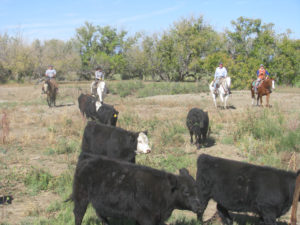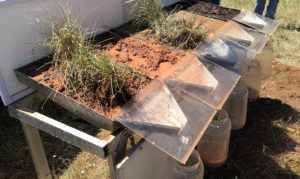Legislating for Healthy Soil in New Mexico
―New Mexico’s Healthy Soil Act (HB 204/a) helps get the word out
New Mexico joined a host of other states this year by enacting the Healthy Soil Act to encourage and help fund education and agricultural practices that enhance the condition of this critical natural resource. Particularly in an arid southwestern state like New Mexico, soil condition has a huge impact on water quantity and quality. Healthy soil absorbs water like a sponge, making it more resilient in a dry year and improves water quality by retaining more water, which reduces runoff from croplands. It also improves transpiration which is important for maintaining moisture conditions in the environment.
Driving through the Cimarron Canyon near Eagles Nest, NM, rancher Kimberly Barmann stops at a small local post office to pin up a flyer for the Soil Health Academy’s upcoming “Regenerative Farming and Ranching” workshops, being held later this month. In fact, she stops at several spots along her way down to Albuquerque, posting the flyers where ranchers and farmers might see them.
“We need to get the word out!” she says, emphatically. Kimberly has been instrumental in organizing the Soil Health Academy workshops throughout the state.
Kimberly is passionate about soil and regenerative land management. There’s an urgency about the subject when she talks. “My daughter says I’m over the top about this,” she admits. “But as I see it, everybody needs to understand the importance of healthy soil – including people who don’t manage land. Ranchers’ and farmers’ livelihoods and our rural communities depend on it.”

Kimberly Barmann and her sister Julia Stafford have been implementing regenerative land management practices since the ’80s on the CS Ranch.
Kimberly is one of six siblings who represent the fourth generation of ownership of the iconic CS Ranch near Cimarron, NM in the northeastern part of the state. She and her sister, Julia Stafford, have been sold on the idea of regenerative land management and have been implementing various practices on their ranch since the mid-1980s.
“Rapid water infiltration on our lands is critical,” Kimberly says, by way of example, describing a recent demonstration on their rangeland where the water on bare soil took over five minutes to sink in, but on covered soil, it took 55 seconds. “Infiltration rates of three to five seconds or less, and no bare soil, is what I’m striving for throughout the CS landscape. The two, along with increased biodiversity, would be powerful indicators of truly healthy soil,” she added. Cover-crops planted in old hay fields on the CS are showing increased fertility and infiltration rates in just over two years.
Citing a report entitled “The Farmer’s Share” on the National Farmers Union website, data compiled by USDA, Kimberly is dismayed that farmers and ranchers, on average, take home only 14.8 cents of every consumer food dollar.
“The terrifying fact is that what we’re doing is not sustainable, and our profits are diminishing more each year” Kimberly explains. “From my experience, we need to go back and look at profits versus production, and what we can do to mimic nature more.”
The Soil Health Academy workshops will be presented by four rancher/farmer consultants who are part of Understanding Ag, a group dedicated to educating and guiding ranchers, farmers, landowners and communities in the principles and practices needed to restore, repair, rebuild, and regenerate what they term their “ranching ecosystem.” Workshop topics include: how to lower input costs through proper nutrient management; how to use cover crops to increase profitability; and the six principles of soil health and adaptive stewardship.
“One of the biggest deterrents to implementing these ideas can be peer pressure,” Kimberly said, which highlights the importance of state legislation in support of soil health. “Legitimizing” regenerative practices through more traditional agricultural channels should help create momentum in this direction among those who work the land. #

Photo: Dan Bloedel, Resource Conservationist at the U.S. Natural Resources Conservation Service (NRCS), demonstrated for ranchers and landowners at a Western Landowners Alliance workshop, the importance of soil health. His traveling “covered soil” demo is particularly dramatic, showing how much better the soil can retain water when plant cover is present.
